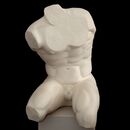after belvedere "science of abstract form" -
An interpretation of an ancient Greek Sculpture known as the Belvedere Torso carved by Apollonius in the 1st Century BC.
The original was used as a model for many of Michelangelo’s figures in the Sistine Chapel. Joshua Reynolds, in his ‘Tenth Discourse’ to Royal Academy students, celebrated the torso’s structure, which he claimed to represent the perfection of the ‘science of abstract form’. The Royal Academy collected copies of the torso for educational purposes.
For me this piece was the perfect exploration into the realm of classical sculpture to develop an understanding of the male anatomy and to get a feel what it must have been like to carve large figurative sculpture in renaissance times.
Material; plaster on wireframe
HWD; 90x50x70cm
July 2023
Available for reproduction in various media; bronze, fibre glass, cold casting
POA
The original was used as a model for many of Michelangelo’s figures in the Sistine Chapel. Joshua Reynolds, in his ‘Tenth Discourse’ to Royal Academy students, celebrated the torso’s structure, which he claimed to represent the perfection of the ‘science of abstract form’. The Royal Academy collected copies of the torso for educational purposes.
For me this piece was the perfect exploration into the realm of classical sculpture to develop an understanding of the male anatomy and to get a feel what it must have been like to carve large figurative sculpture in renaissance times.
Material; plaster on wireframe
HWD; 90x50x70cm
July 2023
Available for reproduction in various media; bronze, fibre glass, cold casting
POA










